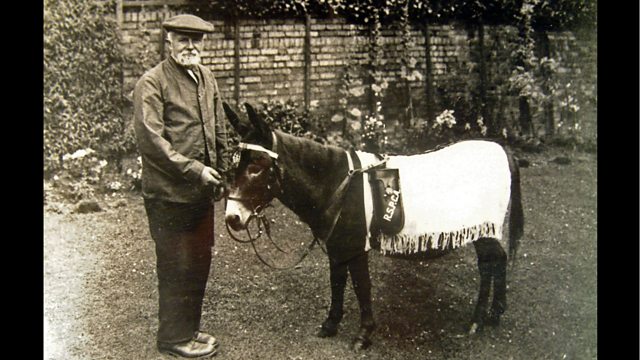Hamilton, Scotland: Jimmy - the War Donkey?
ML3 6BJ - The story of Jimmy, the brave little donkey who served at the Somme…or did he?
ML3 6BJ - Cameronian Museum, Low Parks, Hamilton
The story of Jimmy the Donkey is something of a mystery.
In 1920, at the Peterborough Cattle Market, Jimmy was sold to the RSPCA by a horse dealer called George Walding. And over the next 20 years Jimmy was used in and around Peterborough to raise funds for the charity. But Jimmy had something of a colourful back story. It was claimed that this little black donkey had been at the Somme and had become the mascot of the 1st Battalion of the Cameronian Scottish Rifles.
“Jimmy was born in No-Man’s Land, and the Cameronians brought him back to the British lines, gave him tinned milk and looked after him,” says Sam Morrell, member of the Cameronian Scottish Rifle Association. “Jimmy carried food, ammunition and injured men – everything connected with regimental supplies.”
“They gave him three stripes and made Jimmy a sergeant and he used to lift his hoof and salute an officer. He was quite well known for this,” Sam adds.
In 1920, an ex-soldier named Private Dudley lent weight to Jimmy’s story by saying he recognised Jimmy as his old regimental mascot, but that at the time the donkey had actually been known as Neddy.
Neil Mitchell, a local historian, based in Peterborough, explains: “Private Dudley was with the medical corps and attached to the Scottish Rifles. Private Dudley expanded on the story of the donkey being the regimental mascot. He also told the newspapers of the day that the donkey’s name was Neddy and not Jimmy as the dealer had stated.”
And even with the change of name, Private Dudley’s testimony might have put the donkey’s war record beyond doubt.
But in the 1970’s, horse dealer George Walding’s son made a spectacular admission: Jimmy’s story had been a hoax.
Neil Mitchell says:
“The story was that the George Walding had been to a horse-sale in Southampton. Unfortunately there were a lot of London dealers there and the prices of horses shot up. Not wanting to have a wasted trip, he boughta donkey from a group of gypsies camped close by to the sale. After sending the donkey by rail to Peterborough he tried to sell it to Sanger’s Circus. They didn’t want him, so George Walding took him to the Peterborough Cattle Market and tried to sell him with an elaborate story attached about the donkey being born on the Western Front. Hearing this story, a local RSPCA inspector agreed to buy Jimmy for £20.”
But Sam Morrell is unconvinced: “I find that unbelievable. That was the Somme donkey at Peterborough and I’ve seen the documentation there. That and the fact that were services at Peterborough after the war with Cameronians involved, and the fact that Jimmy was a nationwide hero, says it all.”
After many years fund-raising for the RSPCA, Jimmy died in 1943 and was buried in Peterborough’s Central Park. Whether he did serve at the Front is something we’ll probably never know for sure, but regardless, Neil Mitchell says that we should remember Jimmy for his fund-raising if nothing else: “He deserves to be buried in the park, as a reminder for what he did for the animals that suffer - and why the RSPCA was formed in the first place.”
Image Copyright: HE Media
Duration:
This clip is from
Featured in...
![]()
�������� Radio Scotland—World War One At ��������
Places in Scotland that tell a story of World War One
![]()
Animals—World War One At ��������
Animals' contribution to the war effort
More clips from World War One At ��������
-
![]()
The loss of HMY Iolaire
Duration: 18:52
-
![]()
Scotland, Slamannan and the Argylls
Duration: 07:55
-
![]()
Scotland Museum of Edinburgh mourning dress
Duration: 06:17
-
![]()
Scotland Montrose 'GI Brides'
Duration: 06:41







